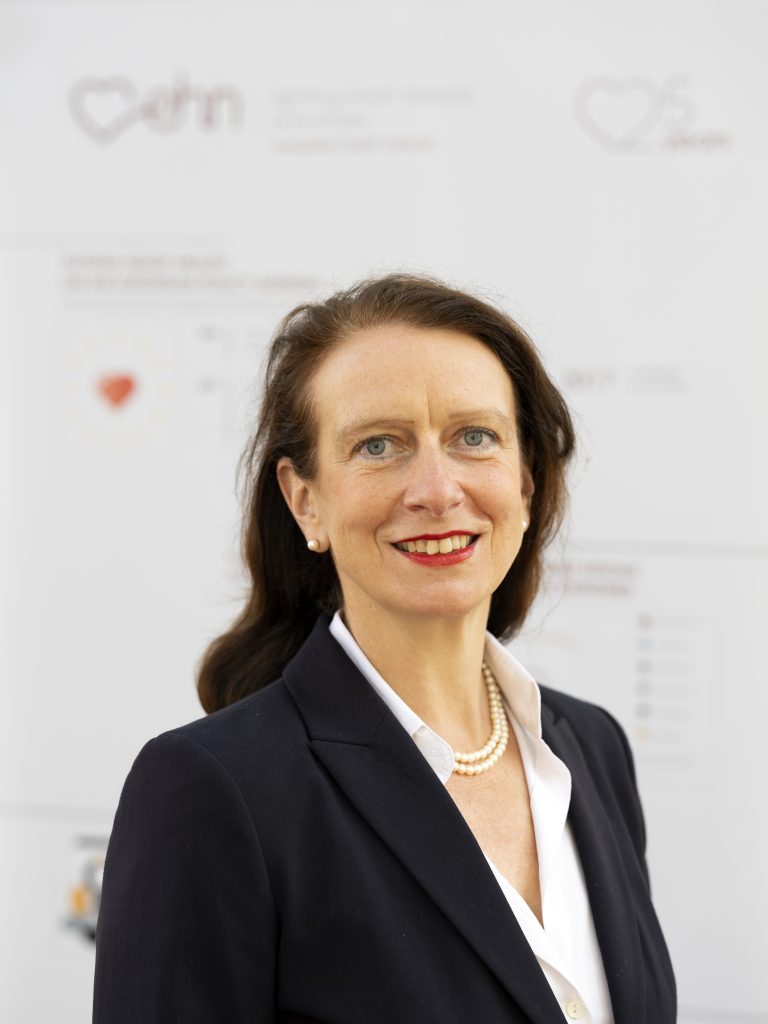Birgit Beger, Chief Executive Officer of the European Heart Network, explains in an interview why Europe needs a joint plan to combat cardiovascular disease and what preventative measures should be taken.
Interview: Dietmar Schobel
HEALTHY EUROPE
Ms Beger, you are the Chief Executive Officer of the European Heart Network. What goals does your organisation pursue?
Birgit Beger: The European Heart Network is a Brussels-based alliance of 27 foundations and associations from 23 countries in the European Region of the World Health Organization (WHO). It is dedicated to fighting heart disease and stroke and supporting patients throughout Europe. Our vision is for every European to have a right to a life free from avoidable cardiovascular disease (CVD). To this end, we work together with diverse organisations, including representatives of European institutions, most notably the European Parliament, the European Commission (EC) and the European Union (EU) Council of Ministers. We are committed to networking, capacity-building and research. Last year, the EC presented Europe’s Beating Cancer Plan, an initiative with 4 billion euros in funding to tackle cancer. A similar plan is needed to reduce the burden of CVD and counteract negative trends, such as the fact that for some years now younger people have also been increasingly affected by various forms of this disease. In other words, we urgently need a “Europe’s Beating Cardiovascular Disease Plan”. This is the goal of the European Heart Network, working in an alliance with 11 other key EU and international health organisations.
HEALTHY EUROPE
How has the prevention and treatment of CVD evolved in recent years and decades?

Birgit Beger: Over the past 50 years, major advances have been made in the prevention and treatment of CVD, and the number of premature deaths has been significantly reduced. But progress has slowed in recent years. Even before the COVID-19 pandemic, an increase in premature deaths from CVD was reported in some countries of the European Union for the first time in 50 years. Overall, CVD remains the No. 1 killer in Europe.
HEALTHY EUROPE
How many people in the European Union does this affect?
Birgit Beger: The burden of CVD is greater than that of any other disease. More than 60 million people in the EU live with it and close to 13 million new cases occur every year. The economic burden for the European Union is estimated at around 210 billion euros per year. Furthermore, with over 1.8 million deaths yearly, cardiovascular events like myocardial infarction and stroke are by far the leading cause of death in the European Union. Of these fatalities, 192,000 occur before the age of 65.
HEALTHY EUROPE
What are the most important measures that can be taken to reduce the burden of disease and the number of premature deaths from CVD?
Birgit Beger: CVD denotes a class of diseases that involve the heart or blood vessels – from coronary artery diseases and stroke to heart failure, peripheral artery disease and aortic aneurysms. The European Heart Network has developed a strategy for the years 2019 to 2023, in which we have identified the three most important areas of action to reduce the burden of disease and death from the various forms of CVD. These are:
* Preventing avoidable CVDs
* Strengthening the position of people with CVDs
* Reinforcing cardiovascular research
In addition, we need to reduce the wide geographical and social disparities that exist. Socially disadvantaged groups are most frequently affected by CVD – and by various other diseases. But there are also major differences between the countries of the European Union. For example, a woman in Lithuania is thirteen times more likely to die from heart disease than a woman in France with reference to the age-standardised death rate. And a man in Bulgaria is eight times more likely to die from stroke than a Frenchman with reference to the age-standardised death rate.
HEALTHY EUROPE
What is important to bear in mind when it comes to the prevention of CVD?

Birgit Beger: Prevention and health promotion are much more cost-effective than therapies, and we know that there is a strong link between lifestyle and CVD. Key risk factors include an unhealthy diet, tobacco use, physical inactivity, alcohol abuse and stress. Experts estimate that up to 90 percent of CVD may be preventable. It’s not just about changing people’s lifestyles, but, more importantly, about creating the conditions that make it easier to lead healthy lives. In other words, making the healthier choices the easier choices. This means that we also have to focus on health determinants like living and working conditions, income and education.
HEALTHY EUROPE
What specifically does this involve?
Birgit Beger: If you want people to be more active, for instance, you also have to offer them good opportunities for cycling and walking – for example, a network of cycle paths and good, safe footpaths. The same applies to nutrition. We advocate sustainable and environmentally-friendly food production and an affordable and accessible supply of healthy food for all. This should also include an easily understandable way of presenting the nutritional values of a food item, such as with the traffic light colours of the Nutri-Score labelling system. Beyond that, there should be a strong focus on reducing environmental impacts and improving housing and working conditions wherever possible to create better conditions for everyone to enjoy a healthy life.
HEALTHY EUROPE
What has been the impact of the COVID-19 pandemic on the various forms of cardiovascular disease?
Birgit Beger: People who have been infected with COVID-19 are relatively often also affected by various forms of CVD. Furthermore, patients with CVD have not received sufficient healthcare because hospitals and GPs have not been as accessible as usual, or because patients have not dared to seek medical attention for fear of infection. On top of that, we have to assume that lack of exercise and obesity have increased among some population groups, for example, among children and adolescents due to school lockdowns. As a result, various forms of CVD may become even more common in the future if no targeted countermeasures are taken.

Birgit Beger is a lawyer and a political scientist and has served as the Chief Executive Officer (CEO) of the European Heart Network since 1 August 2020. Her previous positions include CEO of the European Cancer Organisation and Secretary-General of the Standing Committee of European Doctors.
